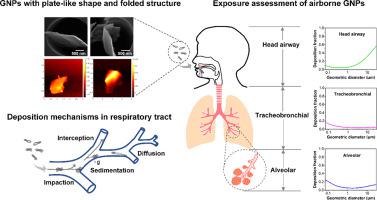NanoImpact ( IF 4.9 ) Pub Date : 2021-01-10 , DOI: 10.1016/j.impact.2021.100292 Hanchao Gao 1 , Tobias Hammer 2 , Xiaole Zhang 2 , Weidong He 2 , Guangbiao Xu 3 , Jing Wang 2

|
The booming development of commercial products containing graphene nanoplatelets (GNPs) triggers growing concerns over their release into the air. Precise prediction of human respiratory system deposition of airborne GNPs, especially in alveolar region, is very important for inhalation exposure assessment. In this study, the pulmonary deposition of airborne GNPs was predicted by the multiple-path particle dosimetry (MPPD) model with consideration of GNPs plate-like shape and folded structure effect. Different equivalent diameters of GNPs were derived and utilized to describe different deposition mechanisms in the MPPD model. Both of small GNPs (geometric lateral size dg < 0.1 μm) and large GNPs (dg > 10 μm) had high deposition fractions in human respiratory system. The total deposition fractions for 0.1 and 30 μm GNPs were 41.6% and 75.6%, respectively. Most of the small GNPs deposited in the alveolar region, while the large GNPs deposited in the head airways. The aerodynamic diameter of GNPs was much smaller than the geometric lateral dimension due to the nanoscale thickness. For GNPs with geometric lateral size of 30 μm, the aerodynamic diameter was 2.98 μm. The small aerodynamic diameter of plate-like GNPs enabled deposition in the alveolar region, and folded GNPs had higher alveolar deposition than planar GNPs. Heavy breathing led to higher GNPs deposition fraction in head airways and lower deposition fractions in the alveolar region than resting breathing.
中文翻译:

量化空气中石墨烯纳米片的呼吸道沉积:板状形状和折叠结构的影响
含有石墨烯纳米片 (GNP) 的商业产品的蓬勃发展引发了人们对它们释放到空气中的日益关注。准确预测空气中 GNPs 的人体呼吸系统沉积,特别是在肺泡区域,对于吸入暴露评估非常重要。在本研究中,考虑 GNPs 板状形状和折叠结构效应,采用多路径粒子剂量学 (MPPD) 模型预测空气中 GNPs 的肺沉积。导出并利用不同的 GNP 等效直径来描述 MPPD 模型中的不同沉积机制。小 GNP(几何横向尺寸d g < 0.1 μm)和大 GNP(d g > 10 μm) 在人体呼吸系统中具有高沉积分数。0.1 和 30 μm GNP 的总沉积分数分别为 41.6% 和 75.6%。大多数小 GNPs 沉积在肺泡区域,而大 GNPs 沉积在头部气道中。由于纳米级厚度,GNP的空气动力学直径远小于几何横向尺寸。对于几何横向尺寸为 30 μm 的 GNP,气动直径为 2.98 μm。板状 GNPs 的小空气动力学直径能够在肺泡区域沉积,折叠 GNPs 比平面 GNPs 具有更高的肺泡沉积。与静息呼吸相比,重度呼吸导致头部气道中 GNPs 沉积分数更高,肺泡区域沉积分数更低。


























 京公网安备 11010802027423号
京公网安备 11010802027423号